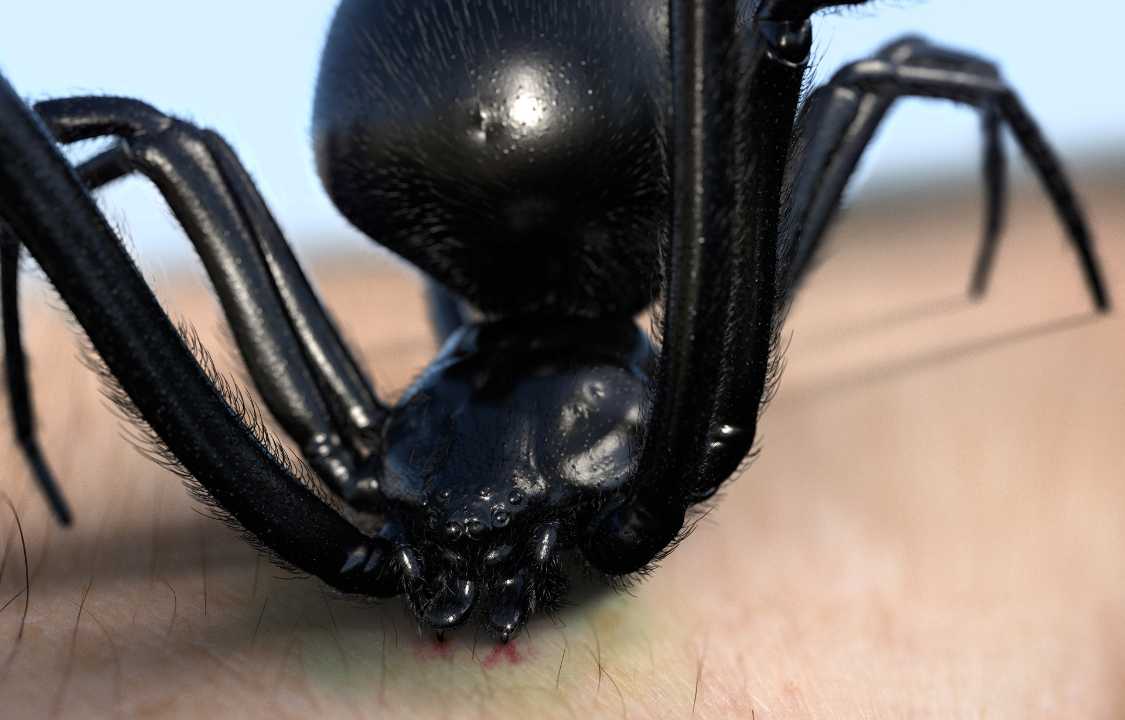Insight
Black Widow Spider Bite
Black widow spiders, intriguing yet feared, belong to the species Latrodectus. These arachnids, though relatively small at about a half-inch in length, are notorious for their potent venom and distinctive markings. In the United States, two primary species of black widows are encountered, each characterized by unique features:
1. Southern Black Widow: Recognized by its glossy black body, the southern black widow is distinguished by a prominent red hourglass mark adorning its abdomen’s underside.
2. Northern Black Widow: This variety is identifiable by a row of red spots running down the middle of its upper abdomen. Additionally, it exhibits two crosswise bars on its underside. Remarkably, these distinctive markings may appear in hues of yellow or white. The northern black widow may display varying colors, such as brown or red legs.
Black widow spiders are nocturnal creatures, tending to be active during the night. They favor concealed, dimly lit corners and crevices, making locations like garages their preferred habitat. Bites from these spiders are not inflicted indiscriminately but rather occur when the spider feels threatened or disturbed.
Understanding the Symptoms of a Black Widow Spider Bite
The venom produced by a black widow spider exerts its effects on the victim’s nervous system. While some individuals may experience mild symptoms, others may develop a more severe response. When bitten, one may encounter the following manifestations:
- Localized Reactions: At the bite site, individuals often report experiencing intense pain, burning sensations, swelling, and redness. Additionally, two distinct fang marks may be visible.
- Muscular Symptoms: Within approximately 8 hours post-bite, muscle pain and stiffness may ensue, affecting various parts of the body.
- Gastrointestinal Disturbances: Symptoms may encompass nausea, vomiting, and intense abdominal pain or cramping.
- Respiratory Complications: Breathing difficulties may emerge, posing a significant concern for those affected.
- Autonomic Nervous System Involvement: Black widow spider bites can induce profuse sweating, sometimes accompanied by a rash and itching.
- Neurological Implications: As the venom targets the nervous system, neurological symptoms may include the swelling of eyelids, weakness, tremors, and even paralysis, which can extend to the legs.
It is vital to emphasize that when individuals exhibit severe symptoms after a black widow spider bite, they must promptly seek medical attention. Given the potential for serious health implications, immediate evaluation and intervention are essential. Notably, these symptoms may resemble those of other medical conditions, necessitating a precise diagnosis.
Crucial Steps in Response to a Black Widow Spider Bite
When suspecting a black widow spider bite, several actions can be undertaken to alleviate symptoms and mitigate potential complications. These steps include:
1. Thorough Cleaning: Wash the affected area with soap and water to reduce the risk of infection.
2. Cold Compress Application: Apply a cold washcloth or an ice pack wrapped in cloth to the bite site. This can help alleviate pain and reduce swelling.
3. Pain Management: Over-the-counter pain relievers like acetaminophen can be administered to alleviate pain and discomfort.
4. Elevation: In cases where the bite occurs on an arm or leg, elevate the affected limb to minimize swelling.
5. Antibiotic Cream or Lotion: Application of an antibiotic cream or lotion to the bite site can help prevent infection.
It is strongly recommended to collect and retain the spider responsible for the bite, ideally placing it in a plastic bag or jar. Bringing the spider to a medical professional can aid in definitive identification.
Upon seeking medical attention, a healthcare provider will conduct a comprehensive assessment, taking into account the symptoms and the clinical presentation. Based on the evaluation, treatment options will be determined. In instances of severe symptoms, patients may require muscle relaxants or more potent pain medications. Hospitalization is rarely necessary.
In the most critical cases, the administration of antivenin may be considered. Antivenin is derived from components present in the blood of horses and acts to neutralize the venom produced by black widow spiders. This neutralization prevents the venom from causing further harm to the victim. However, the use of antivenin is typically reserved for situations with a high degree of medical certainty, often involving consultation with a specialist experienced in managing black widow spider bites. Notably, antivenin may elicit a range of side effects, necessitating close monitoring for approximately 8 to 12 days post-administration.
Preventive Measures against Black Widow Spider Bites
Proactive steps can be taken to reduce the risk of black widow spider bites. These measures include:
- Maintain Clean Storage Areas: Ensure that storage spaces, including garages and sheds, are kept clean and free of clutter. Black widow spiders favor dimly lit and concealed environments.
- Avoid Concealed Outdoor Spaces: Be cautious around areas that may serve as hiding spots for black widow spiders, such as woodpiles and fallen tree branches.
By delving into a comprehensive understanding of the characteristics and behavior of black widow spiders, recognizing the distinctive symptoms that may accompany their bites, and responding with swift medical attention when necessary, individuals can empower themselves to effectively manage and mitigate the potential risks associated with encounters with these enigmatic arachnids. This knowledge equips individuals with the tools needed to make informed decisions in the event of a spider bite and to ensure the best possible outcome for their health and well-being.
Moreover, it’s essential to adopt proactive preventive practices to create a safer living environment. This includes taking steps to reduce the likelihood of black widow spiders inhabiting your surroundings, such as regular cleaning and tidying to eliminate potential hiding places. Ensuring that you and your family are aware of the habits and habitats of these spiders can go a long way in reducing the chances of an encounter. In essence, being informed and proactive in your approach to dealing with black widow spiders can significantly enhance your safety and peace of mind, making your environment a less hospitable place for these creatures.

